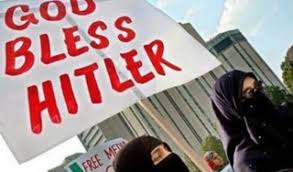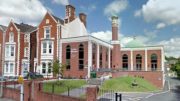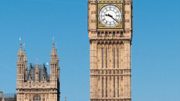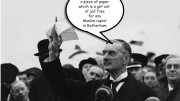Yesterday I put up an article about a book that has been published on the subject of the plight of the Jews in Islamic lands. This book, ‘Exile in the Maghreb’ explodes some of the myths promoted by leftist and Orientalist academics about how lands ruled by Islam were islands of tolerance for Jews when compared to Europe. Exile in the Magreb is an answer to the many comforting lies we have been told about how under Islam Jews were treated well. The truth of the matter is that life under Islam was not comfortable, was not free and the Islamic culture that ruled was without a doubt, not tolerant.
A correspondent on the Gab platform read the post on ‘Exile in the Maghreb’ and mentioned that a similar article had been written by David Levy. This article comprehensively busted the lie told by both Muslims and Islamophiles, that Islamic anti-Semitism did not exist prior to the recreation of the State of Israel. My interlocutor said that he could not find a link to this article on the webs so he emailed me his digital copy of the article which is what I am republishing now.
I believe this piece should be required reading both for Jews and non Jews about what life was really like for religious and cultural minorities in the lands ruled by the followers of Mohammed. I also hope it is read by those Jews who have the misfortune to have left leaning or navie Rabbonim who are feeding, either deliberarately or because of thier ignorance of history, a false and sanitised version of Islam’s relationship with other faiths, and especially its relationship with Judaism.
Muslim pogroms against Jews prior to Zionism – David Levy
Introduction
A popular myth amongst those that describe themselves as Anti-Zionists is that this conflict between Jews and Muslims only started when large scale Jewish immigration to Palestine commenced. This myth has become widely accepted in the Main Stream Media (MSM) and in academic institutions it has become almost universally accepted that Jews and Muslims lived in peace prior to 1948. As such this myth is taught as fact in schools and universities worldwide by educators who have scant regard for the truth.
Why did I write this?
Historic intolerance of Judaism by Muslims cannot be denied any longer as it’s a key part of today’s conflict. By denying 1400 years of persecution Muslims are able to play the role of the sole victim in this conflict and thus the Jewish people are thus blamed for everything.
This is unacceptable.
Like all other pogroms-including those in Europe- the above demonstrates the helplessness of the Jewish condition prior to the formation of the state of Israel.
Prior to the formation of Israel Jews could not defend themselves from Christians or Arabs, they could not demand treatment as equals from Christians or Arabs and thus the life of a Jew had no value other than what was allowed by the relevant rulers.
Over the last 1400 years several large scale Muslim pogroms against Jews were recorded, unfortunately most events went undocumented or were very poorly documented. This is by no means a definitive list of pogroms carried out by Muslims against Jews- if anyone has any further information or corrections they would like me to add please feel free to contact me
Iberian Peninsular.
During Islamic Occupation of the Iberian Peninsula starting in the 9th century the Jewish communities fared slightly better than those in Christian lands- however they were anything but violence or persecution free- if one where to examine Moorish Rule you would have to come to the conclusion that the Jewish Golden age was in spite of Islamic rule, not because of it.
– Cordoba in 1011: after the siege of Cordoba by Sulayman ibn al-Hakam the Jewish residents were rounded up and more than 2000 slaughtered.
– Granada in 1066.[4] In the 1066 Granada massacre, the first large pogrom on European soil, a Muslim mob crucified the Jewish vizier Joseph ibn Naghrela and massacred about 4,000 Jews. Some versions of the massacre put the figure at 8-10000 deaths.
Instrumental in provoking the massacre of Jews was the anti-Semitic poem of Abu Ishaq written in Granada in 1066.
“Do not consider it a breach of faith to kill them, the breach of faith would be to let them carry on.
They have violated our covenant with them, so how can you be held guilty against the violators?
How can they have any pact when we are obscure and they are prominent? Now we are humble, beside them, as if we were wrong and they were right!
In other words the Jews have no right to hold positions of power over Muslims- an attitude that is found throughout the Muslim world today and a fundamental issue at the core of the Arab Israeli conflict.
Morocco
The large Jewish community in Morocco has had four major Pogroms reordered- massacres in Arabs lands are extremely hard to get details on due to the lackadaisical attitude authorities had when it came to murdered non-Muslims.
Fez In 1033: In 1033, the forces of Prince Abu-Alquemal Tamim, perpetrated a massacre of Jews in Fez following their conquest and plunder of the city. The Prince’s forces killed over six thousand Jews, Jewish belongings and properties where appropriated, and following in the footsteps of Mohammed example the Jewish women of the city where sold into slavery.
City of Fez Morocco
Fez and Marrakesh in 1146: The largest attacks occurred in Fez and Marrakesh when over 100,000 were killed by muslims in Fez and another 120,000 in Marrakesh . An account by Solomon Cohen dated January 1148 AD describes the Almohad conquests:”Abd al-Mumin … the leader of the Almohads after the death of Muhammad Ibn Tumart the Mahdi … captured Tlemcen [in the Maghreb] and killed all those who were in it, including the Jews, except those who embraced Islam. … [In Sijilmasa] One hundred and fifty persons were killed for clinging to their [Jewish] faith. … One hundred thousand persons were killed in Fez on that occasion, and 120,000 in Marrakesh. The Jews in all [Maghreb] localities [conquered] … groaned under the heavy yoke of the Almohads; many had been killed, many others converted; none were able to appear in public as Jews.”
– Fez: Mobs murder many thousands of Jews in 1276 in a rampage that lasts over a week
– Fez : (again) in 1465, leaving only 11 Jews alive, estimates are between 50 000 to 60 000 killed.
– Jews were also forced to live in walled ghettos where enforced poverty was the rule. This discrimination against Jews carried on until France occupied Morocco in 1912.
It must however be said that it is only because of the direct intervention of King Muhammad in 1940 that 250 000 Jews weren’t sent to Nazi camps.
Iraq
There were many instances of violence against Jews during their long history in Iraq, far too many as well as numerous enacted decrees ordering the destruction of synagogues in Iraq as well as a lot of forced conversion to Islam. Two major Massacres of Jews are recorded in recent (Pre Zionism ) history where some 1500 -3000 Jews where slaughtered in total.
– Basra: 1776
– Baghdad : in 1828 jews were massacred in Baghdad.
– There was another massacre in Barforoush in 1867.
Persia
Jews have been a part of Persian culture for over 2500 years. Prior to 1979 persecution was very rare and massacres even rarer, however two very disturbing incidences are recorded- again details of the massacre are scarce other than knowing it took place.
– The massacre in Barfurush (1867).
– And Meshed in 1839, in the eastern Persian city of, a mob burst into the Jewish Quarter, burned the synagogue, and destroyed the Torah scrolls. This is known as the Allahdad incident. It was only by forcible conversion that a massacre of hundreds of Jews was averted.
Syria Details of massacres in Arabs lands are extremely hard to get details on due to the lackadaisical attitude authorities had when it came to murdered non-Muslims. Numerous killing are recorded throughout Syrian history by both Muslims and Christians.
In recent (Pre Zionism ) history only one incident needs to be discussed- The Damascus affair –which occurred in 1840. When an Italian monk and his servant disappeared in Damascus charge of ritual murder was immediately brought against a large number of Jews in the city. All were found guilty and killed.
Egypt
The Treaty of Alexandria (November 8, 641), which sealed the Arab conquest of Egypt, expressly stipulates that the Jews are to be allowed to remain in that city.
– The caliph al-Ḥakim (996-1020) vigorously applied the Pact of Umar, and compelled the Jews to wear bells and to carry in public the wooden image of a calf. A street in the city, al-Jawdariyyah, was inhabited by Jews. Al-Ḥakim, hearing that they were accustomed to mock him in verses, had the whole quarter burned down and a large number of Jews slaughtered.
– Al-Malik al-Thahir, (1260–77), doubled the tribute paid by the “ahl al-dhimmah.” At one time he had resolved to burn all the Jews, a ditch having been dug for that purpose; but at the last moment he repented, and instead exacted a heavy tribute, during the collection of which many perished (±300)
– In 1324 the Jews were accused of incendiarism at Fostat and Cairo; the Jewish community was forced to buy their freedom with 50,000 gold pieces- if not they would have been executed.
– In 1468 the Jewish was once again forced to buy their freedom with a payment of 75,000 gold pieces thus once again forcing the Jewish communities in abject poverty.
– Blood libels occurred at Alexandria in 1844, in 1881, and in Jan 1902., the result of which a number of Jews were killed.
– During British rule, and under King Fuad I, Egypt was friendly towards its Jewish population, though Egyptian nationality was denied to 90 % of Egyptian Jews regardless of how many generations they resided in the country.
Palestine
Palestine The Jews of Palestine where subject to routine prejudice and persecution. These were punctuated by hundreds of pogroms by Arabs, Crusaders and Turks. These were punctuated by pogroms or “events.” Such “events” (Meora’ot in Hebrew) were regarded more or less as natural occurrences like earthquakes, and were used to mark time: “It happened on Purim, three years after the me’oraot was not uncommon.
The 1517 Hebron pogrom was a violent attack against the Jews of Hebron soon after the Ottomans had taken control of Palestine in 1517. An account of the event, recorded by Japheth ben Manasseh in 1518, mentions how the onslaught was initiated by Turkish troops led by Murad Bey, the deputy of the Sultan from Jerusalem. Jews were attacked, beaten and raped, and many were killed as their homes and businesses were looted and pillaged. It has been suggested that the stable financial position of the Hebronite Jews at the time was what attracted the Turkish soldiers to engage in the mass plunder.Others suggest the pogrom could have in fact taken place in the midst of a localised conflict, an uprising by the Arabs against the new Ottoman rulers Those who survived the calamity fled to Beirut and Jews only returned to Hebron 16 years later in 1533.
The 1834 Hebron pogrom or Yagma el Gabireh (the “great destruction”), occurred on 24 July 1834 when the forces loyal to Ibrahim Pasha attacked the city of Hebron in order to crush the Peasants’ Revolt. The general population of the town was subjected to an orgy of violence at the hands of Egyptian soldiers following the fall of the city. Although the Jews had not been part of the uprising and Ibrahim Pasha had reassured the them that their quarter would be left unharmed, Hebronite Jews, bystanders to the warring factions, were attacked in what has been called a massacre and pogrom. The gravest incident was the rape and murder of five young Jewish girls. The calamity was remembered by the Jews of Hebron as Yagma el Gabireh, or the “great destruction. In Hebron, the troops “vented their anger on the Jewish quarter which they pillaged with terrifying cruelty.” The Jewish community of Hebron was left destitute and their number “greatly reduced” to about 120 families.
Hebron
Of all of these in recent (Pre Zionism )the Safed pogrom of 1834 stands out for its savagery. This pogrom is known in Jewish history as ‘The great plunder of
Safed
’ and it lasted for a remarkable 33 days of uninterrupted murder, raping and pillaging of Jewish lives and property (15th June 1834 to the 17th of July) The motivation, along with greed, was clearly anti-Semitic. From a contemporary traveler, we learn that:
The Jews of the place, who were exceedingly wealthy, had lived peaceably in their retirement until the insurrection which took place in 1834, but about the beginning of that year a highly religious Mussulman called Mohammed Damoor went forth into the market-place, crying with a loud voice, and prophesying that on the fifteenth of the following June the true Believers would rise up in just wrath against the Jews, and despoil them of their gold and their silver and their jewels…When that day dawned the whole Mussulman population of the place assembled in the streets that they might see the result of the prophecy. Suddenly Mohammed Damoor rushed furious into the crowd, and the fierce shout of the prophet soon ensured the fulfilment of his prophecy. Some of the Jews fled and some remained, but they who fled and they who remained, alike, and unresistingly, left their property to the hands of the spoilers. The most odious of all outrages, that of searching the women for the base purpose of discovering such things as gold and silver concealed about their persons, was perpetrated without shame. The poor Jews were so stricken with terror, that they submitted to their fate even where resistance would have been easy…When the insurrection was put down some of the Mussulmans (most probably those who had got no spoil wherewith they might buy immunity) were punished, but the greater part of them escaped. None of the booty was restored, and the pecuniary redress which the Pasha had undertaken to enforce for them had been hitherto so carefully delayed, that the hope of ever obtaining it had grown very faint.
The Petach Tikva in 1886 is widely recognised as the first organized Arab attack on a Jewish settlement. The aim here was not to pillage –as in the past- but to exterminate the Jewish presence once land had been bought and paid for(and thus the precedent is set)- its only because of the steadfastness –and the arrival of the Pashas troops that the Jewish settlement wasn’t razed.
Yemen
Full blown Muslim persecution of the Jews did not gain full force until the Zaydi clan seized power in the early 10th century. The Zaydi enforced a statute known as the Orphan’s Decree, anchored in their own 18th century legal interpretations and enforced at the end of that century. It obligated the Zaydi state to take under its protection and to educate in Islamic ways any dhimmi (i.e. non-Muslim) child whose parents had died when he or she was a minor. The Orphan’s Decree was ignored during the Ottoman rule (1872–1918), but was renewed during the period of Imam Yahya (1918–1948).
Under the Zaydi rule, the Jews where exposed to the usual depredations and humiliations and persecutions force upon non-muslims under Islamic law.
Jews were considered to be impure, and therefore forbidden to touch a Muslim or a Muslim’s food.
They were obligated to humble themselves before a Muslim, to walk to the left side, and greet him first.
They could not build houses higher than a Muslim’s
Jews could not ride a camel or horse, and when riding on a mule or a donkey, they had to sit sideways.
Upon entering the Muslim quarter a Jew had to take off his foot-gear and walk barefoot.
If attacked with stones or fists by Islamic youth.
A Jew was not allowed to defend himself. In such situations he had the option of fleeing or seeking intervention by a merciful Muslim passer by.
Jews where not allowed to build new temples and where not allowed to repair existing temples with out the rulers permission even if the temples where damaged or destroyed by muslims. Well especially then.
Jews where also forced to pay a Jizya Tax, which under various rulers was up to 50% of annual income. This ensured a continual state of poverty Yemenite.
At various times these laws and others where enforced in most arabs lands such as Palestine (occupied Judea), Egypt and lands conquered by Egypt, Morocco etc etc.
Jews also experienced violent persecution at various times.
At the 12th century, the Yemeni ruler ‘Abd-al-Nabī ibn Mahdi left Jews with the choice between conversion to Islam or martyrdom.
At the 17th century, under the rule of Al-Mahdi Ahmad, Jews were expelled en masse from all parts of Yemen to the province of Mawza. Many thousands of Jews died of starvation and diseases as consequence, their houses and property were taken from them, and many synagogues were destroyed or transformed into mosques.
All in all , one third of the Yemenite Jewish population died because of Islamic supremacism, the same Islamic supremacism that today threatens Israel on a daily basis.
References
1. Anti-Zionism -A thinly veiled disguise for organized hatred of Jews that has become morally acceptable in a number of cultures –specifically in Arab and Muslim countries and left wing and “Liberal” political movements.
Codex Judaica: Chronological index of Jewish history, covering 5,764 years of Biblical, Talmudic & post-Talmudic history. Máttis Kantor Press. p. 176. Benny Morris cites the killing of approximately two thousands Jews Benny Morris (1999). [[1]Righteous victims: a history of the Zionist-Arab conflict, 1881-2001]. Random House, Inc.. p. 184.
4. Anti-Semitism: myth and hate from antiquity to the present by Frederick M. Schweitzer, Marvin Perry pg. 267–268.
5. Granada by Richard Gottheil, Meyer Kayserling, Jewish Encyclopedia. 1906 ed.
6. The Jews of Islam. Bernard Lewis, pp. 44–45.
7. Moroccan Jews:http://www.usa-morocco.org/moroccan-jews.htm
8. The Forgotten Refugees – Historical Timeline. http://www.theforgottenrefugees.com/ 9. Moura, Jozé de Santo Antonio (1827). “Memoria sobre as dinastias mohammetanas, que tem reinado na Mauritania, com a serie chronologica dos soberanos de cada huma dellas”. Memórias de Academia das Ciências de Lisboa. Lisbon: Academia Real das Sciencias de Lisboa. pp. 47–140. http://books.google.com/books? id=E9NOAAAAYAAJ&dq=fez+1033+tamim&source=gbs_navlinks_s. Retrieved 2011-03-30.
10. H. Z. Hirschberg, A History of the Jews of North Africa, vol. I (Leiden: Brill, 1974), pp.127–28. Solomon Cohen’s account comports with Arab historian Ibn Baydhaq’s sequence of events. Citing from The Legacy of Jihad: Islamic Holy War and the Fate of Non-Muslimsby Andrew G Bostom, ed. The Moroccan Jewish experience: a revisionist view. Jerusalem Quarterly 9: 111-123
11. The Treatment of Jews in Arab/Islamic Countries.
12. The terror behind Iraq’s Jewish exodus by Julia Magnet (The Telegraph, April 16, 2003) 13. Bat Ye’or, The Dhimmi, 1985, p.61
14. http://en.wikipedia.org/wiki/Farhud#Events_preceding_the_Farhud
15. The Sack of Basra and the Farhud in Baghdad, (Arabic Political Memoirs. London), pp. 283–314
16. Righteous Victims: A History of the Zionist-Arab Conflict, 1881-2001. Morris, Benny, pp. 10-11.
17. Jadid al-Islam: The Jewish “New Muslims” of Meshhed. Raphael Patai
18. The Damascus Affair: ‘Ritual Murder’, Politics, and the Jews in 1840 Jonathan Frankel 19. http://en.wikipedia.org/wiki/History_of_the_Jews_in_Egypt#Arab_rule_.28641_to_1250.29
20. Palestine Massacre: The forgotten pogrom: Safed 1834 http://www.zionism-israel.com/log/archives/00000349.html
21. Encyclopaedia Judaica (2007). Fred Skolnik; Michael Berenbaum Macmillan Reference USA in association with the Keter Pub. House. p. 746.
22. Hebron Jews: memory and conflict in the land of Israel. Jerold S. Auerbach (30 July 2009). p. 40.
23. Studies on Palestine during the Ottoman period. Moshe Maʻoz (1975). p. 147.
24. Reshaping Palestine: from Muhammad Ali to the British Mandate, 1831-1922 Martin Sicker (1999).
25. http://www.ou.org/about/judaism/bhyom/mar.htm
26. Righteous Victims: A History of the Zionist-Arab Conflict, Benny Morris 1881-2001. Vintage Books, 2001, pp. 10-11.
27. Jewish Communities in Exotic Places,” by Ken Blady, Jason Aronson Inc., 2000, page 9 28. Jewish Communities in Exotic Places,” by Ken Blady, Jason Aronson Inc., 2000, page 10 29. (The Jews of the Middle East and North Africa in Modern Times, by Reeva Spector Simon, Michael Menachem Laskier, Sara Reguer editors, Columbia University Press, 2003, page 392
30. The Epistles of Maimonides: Crisis and Leadership, ed.:Abraham S. Halkin, David Hartman, Jewish Publication Society, 1985. p.91
31. B. Z. Eraqi Klorman, The Jews of Yemen in the Nineteenth Century: A Portrait of a Messianic Community, BRILL, 1993, p.46





